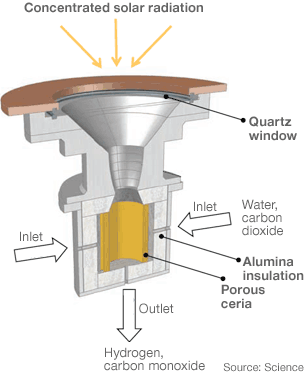Another prototype of a solar reactor
 Recently , the Greek project Hydrosol was discussed at Habré, within which a thermochemical reactor was created that splits water under the influence of solar heat (in the presence of a catalyst). The current prototype of such a reactor has already been launched in Spain, and now engineers are planning to build another one with a capacity of 1 MW. As a catalyst, they use some ceramic “honeycombs” coated with ferrite structures with a lack of oxygen. The material also includes nickel and zinc.
Recently , the Greek project Hydrosol was discussed at Habré, within which a thermochemical reactor was created that splits water under the influence of solar heat (in the presence of a catalyst). The current prototype of such a reactor has already been launched in Spain, and now engineers are planning to build another one with a capacity of 1 MW. As a catalyst, they use some ceramic “honeycombs” coated with ferrite structures with a lack of oxygen. The material also includes nickel and zinc.In this area, another group of scientists from the California Institute of Technology and the Federal Technical Institute of Switzerland is conducting research. Just two days ago they published their scientific work, in which they offer a slightly different process technology. Their solar reactor extracts hydrogen from water and can also reduce CO 2 to extremely useful CO. Cerium oxide is used as a catalyst.
Scientific work published in the journal Science [Science 24 December 2010: Vol. 330 no. 6012 pp. 1797-1801. DOI: 10.1126 / science.1197834].
Unlike the Greek reactor, this option is described in detail and documented in scientific work.
')
The reactor has already been tested and confirmed its stable and continuous work on the generation of fuel over 500 cycles. Apparently, there are cycles in the process of which cerium oxide acquires one of two possible states: CeO 2 or Ce 2 O 3 .
Ce 2 O 3 + CO 2 → 2CeO 2 + CO (at low temperature)
Ce 2 O 3 + H 2 O → 2CeO 2 + H 2 (at low temperature)
4CeO 2 + temperature → 2Ce 2 O 3 + O 2 (high temperature)
True, the efficiency of the reactor is not too impressive: only 0.7-0.8%. But scientists say that this is only due to the design of the reactor , that is, exclusively with physical factors (for example, too much heat loss) that can be corrected (for example, better thermal insulation). They say that they can easily bring the efficiency up to 19% and then the reactor will become quite suitable for commercial use.
In any case, thermochemical splitting of water is today considered the most effective way to convert solar energy into chemical.
Source: https://habr.com/ru/post/110718/
All Articles